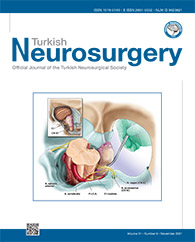2The First Medical Centre, Chinese PLA General Hospital, Department of Neurosurgery, Beijing, 100853, China
3The Second Hospital of Southern District of PLA Navy, Department of Neurosurgery, Sanya, 572000, China
4Qingdao Special Servicemen Recuperation Centre of PLA Navy, Qingdao, 266071, China
5The First Medical Centre, Chinese PLA General Hospital, Department of Radiology, Beijing, 100853, China DOI : 10.5137/1019-5149.JTN.30092-20.1 AIM: To analyze certain magnetic resonance imaging (MRI) features as well as six major genetic biomarkers, investigated their associations, and evaluated their prognostic roles in glioblastomas (GBMs).
MATERIAL and METHODS: Strict criteria included newly diagnosed GBM with optimal treatments. Simple manual imaging characteristics (tumor side, location, enhancement, diameter, depth, radiographic necrosis, and edema) were obtained from preoperative conventional MRI. Furthermore, all the status of the MGMT promoter, Chromosome 1p and 19q, IDH, TERT, and BRAF in tumor tissues were detected.
RESULTS: Among 126 inpatients, 60 cases were selected and enrolled in the study. The status of the MGMT promoter was significantly associated with the grade of radiographic necrosis (p=0.033). The rate of 19q deletion was significantly higher in tumors with the ring-shaped peritumoral edema (PTE) (p=0.035) and in tumors with the ring-enhanced trait (p=0.023). Univariate analysis showed that a low PTE index and MGMT promoter methylation were both unfavorable prognostic factors. While the PTE index statistically dropped out, the status of the MGMT promoter and the depth of the tumor were observed to be independent prognostic factors in multivariate analysis.
CONCLUSION: Based on simple neuroimaging metrics, novel connections between features of preoperative conventional MRI and status of major genetic biomarkers were observed, especially for the MGMT promoter and 19q.
Keywords : Biomarkers, Glioblastoma, MRI, Prognosis




